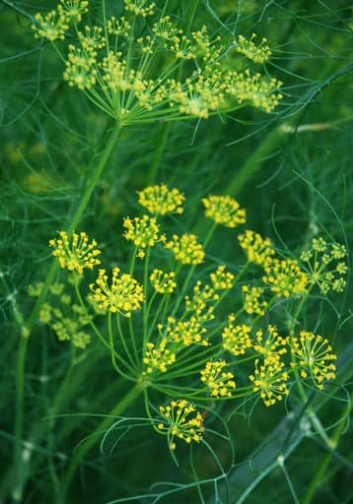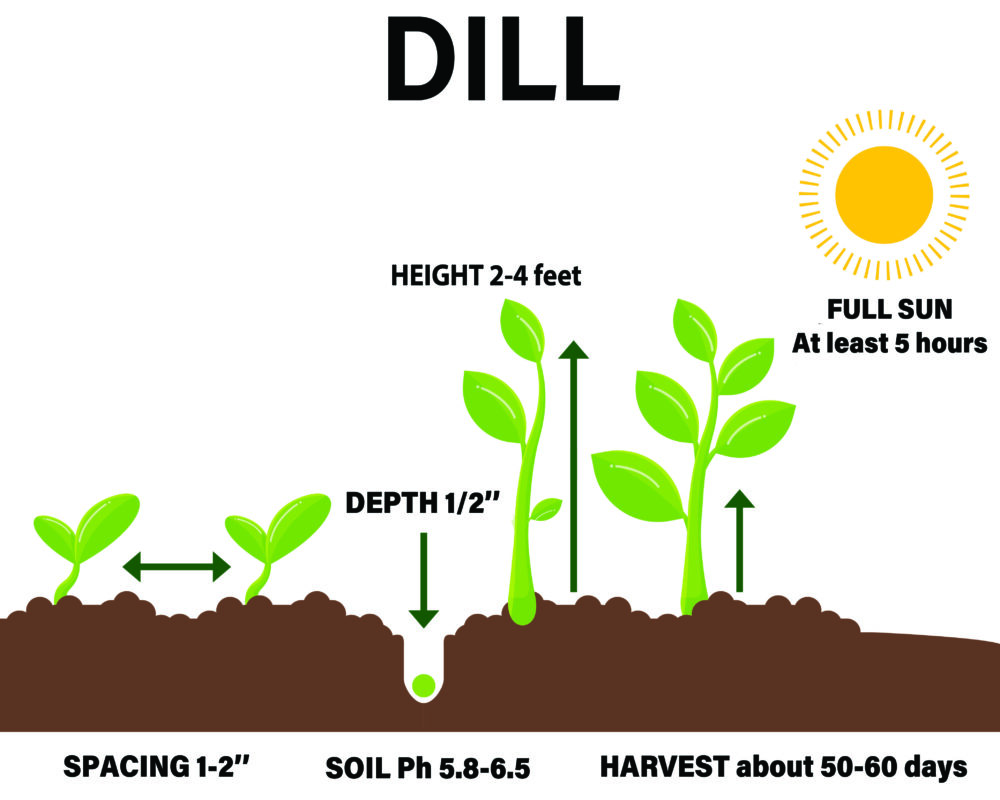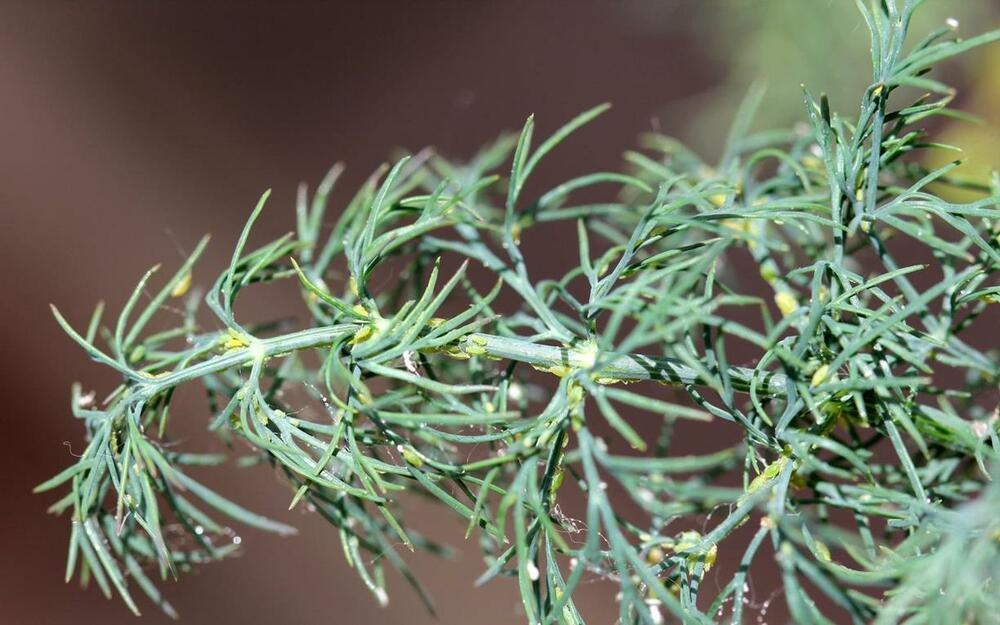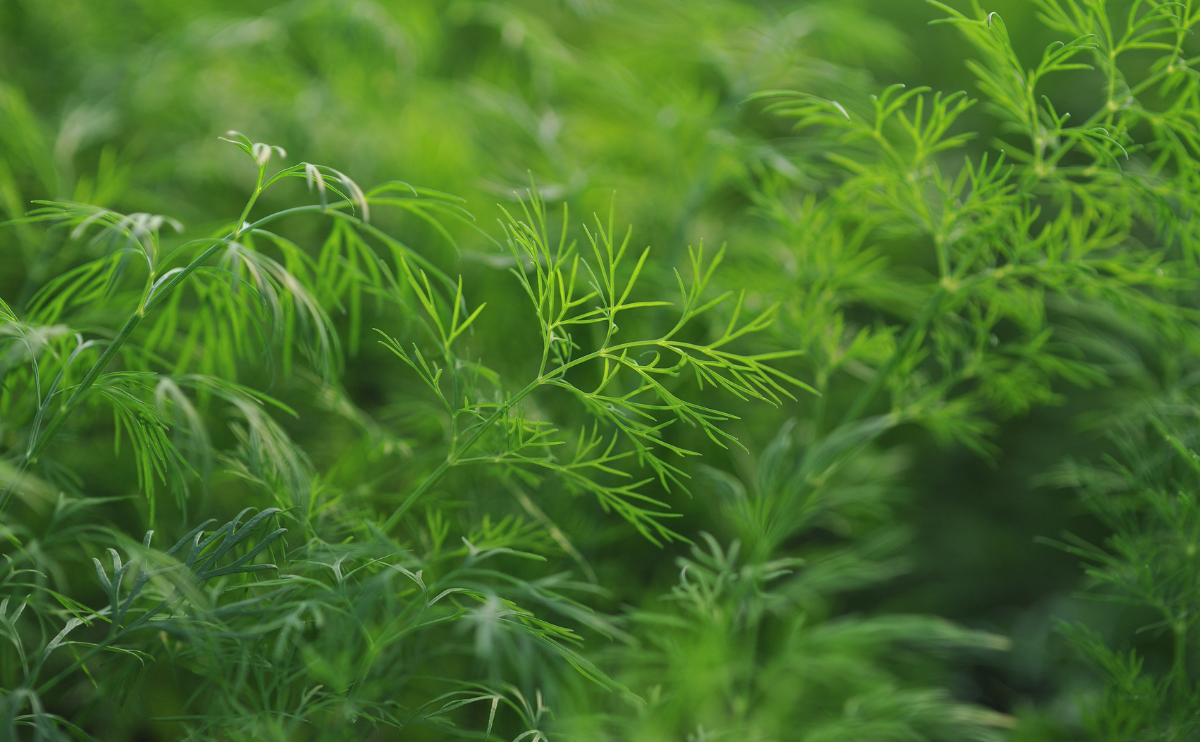Dill is a culinary herb with a distinctive flavor that’s a cross between celery and fennel. Native to Europe and Asia, dill plays a big role in seasoning pickled foods that will be jarred or canned and stored for winter. Beyond that, both the leaves and seeds are used to season a variety of dishes.
Dill’s feathery foliage can be quite ornamental, which makes it a nice addition to flower beds, where it will attract pollinators and butterflies, especially the Eastern black swallowtail butterfly. It blends well with other plants, whether used as foliage or for a bright spot of color—just be sure to keep its self-sowing habit in check by deadheading flower heads before they go to seed.
Although it has a delicate appearance, dill is actually a fairly cold-hardy plant. It’s best sowed from seed in early spring after the chance of frost has passed, and it will grow quickly, with seedlings appearing in about ten days. Mature plants are multi-branched and upright with finely dissected leaves. The wide, flat flowers that can make the plant top-heavy and cause it to bend over. The entire plant is extremely fragrant—the foliage and seeds are most commonly thought of as seasonings, but the flowers are also edible.

| Botanical Name | Anethum graveolens |
| Common Name | Dill |
| Plant Type | Annual |
| Mature Size | 3 to 5 ft. tall, 2 to 3 ft. wide |
| Sun Exposure | Full sun |
| Soil Type | Rich, well-drained |
| Soil pH | 6.5 (slightly acidic) |
| Bloom Time | Late summer, early fall |
| Flower Color | Yellow |
| Hardiness Zones | 2–11 (USDA) |
| Native Area | Europe, Asia |

When to Plant?
This will be determined by your planting zone. There is a final frost date for each area. As a result, you can plan your gardening activities around this date. Check our Frost Dates Across North America: First & Last Frost Dates Chart. However, the date will not be the same for every plant.
How to Plant
Dill can be sown in a 6 – 8″ deep container. It is the most convenient to place elongated containers in the shape of a rectangle on the windowsill. Plant dill in full sun and protect it from strong gusts of wind. The plant can survive temperatures down to 25°F. You can sow dill seeds directly into your container.
Fill it up with any soilless potting mix, making sure there are drainage holes in the bottom first.
Start dill off from seed anytime between mid-spring and mid-summer. Prepare the soil well, choosing a fertile, open site in full sun. Sow dill seeds thinly in shallow, ½ inch deep, rows, and cover lightly with soil.

Planting dill seed is easy. Dill planting is simply done by scattering the seeds in the desired location after the last frost and then lightly covering the seeds with soil. Water the area thoroughly.
Dill is the perfect plant to grow in containers. Dill is a popular herb in the kitchen, flavoring everything from pickles to fish. Its leaves are used fresh or dried as an herb in dips, soups, salads, and other dishes. Companions – Cucumber, Collards, Lettuce, Zinnia, Sprouts, Brussels, Cabbage, Tomato, Corn, Broccoli, and Cauliflower.
How to Cultivate
Soil – Average, well-drained soil amended with compost.
Soil temperature should range from 50°F to 70°F.
Sun – Full sun.
If the container is indoors, place the plants where they will receive at least 5 to 6 hours of direct sunlight each day.
Frost-tolerant – Seedlings may need protection from light frosts.
Cannot tolerate hard freezes.
Spacing:
Seeds – 1″ to 2″ apart.
Seedlings – 8″ to 12″ apart.
How to Harvest
The dill will be ready for harvest within about 8 – 10 weeks after the seeds were sown.
Leaves can be harvested as soon as they are big enough to use.
Clip them close to the stem in the early morning or late evening.
Gather and dry leaves when plants are 10 inches tall.
To harvest the dill leaves, regularly trim off the desired amount of leaves you need for cooking.
Hydroponics
Germination: To start growing dill hydroponically, begin by germinating the seeds in a separate container. You can use a paper towel, soil, or any other germination medium.
Ph range: Once the seeds have sprouted, prepare your hydroponic system with a ph range of 5.5 to 6.5. Dill prefers slightly acidic soil.
EC and PPM: Keep the electrical conductivity (EC) and parts per million (PPM) of your hydroponic system at a moderate level. Aim for an ec range of 1.5-2.5 ms/cm and a ppm range of 750-1250 ppm.
Humidity: Dill requires a high level of humidity, between 50% to 80%. You can increase humidity by using a humidifier or by placing a tray of water near your hydroponic system.
Light hours: Provide your dill plants with 14 to 16 hours of light each day. You can use grow lights or natural sunlight to achieve this.
Temperature air and water: Dill prefers moderate temperatures. Keep the air temperature between 60°f to 70°f (15°c to 21°c), and the water temperature between 65°f to 75°f (18°c to 24°c).
With proper care, your hydroponic dill should be ready to harvest in about six to eight weeks.
Common Pests and Diseases
Willow-carrot aphid (Cavariella aegopodii)

Symptoms: Small soft bodied insects on underside of leaves and/or stems of plant; usually green or yellow in color; if aphid infestation is heavy it may cause leaves to yellow and/or distorted, necrotic spots on leaves and/or stunted shoots; aphids secrete a sticky, sugary substance called honeydew which encourages the growth of sooty mold on the plants
Cause: Insect
Management
If aphid population is limited to just a few leaves or shoots then the infestation can be pruned out to provide control; check transplants for aphids before planting; use tolerant varieties if available; reflective mulches such as silver colored plastic can deter aphids from feeding on plants; sturdy plants can be sprayed with a strong jet of water to knock aphids from leaves; insecticides are generally only required to treat aphids if the infestation is very high – plants generally tolerate low and medium level infestation; insecticidal soaps or oils such as neem or canola oil are usually the best method of control; always check the labels of the products for specific usage guidelines prior to use



